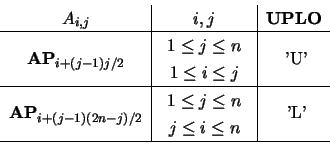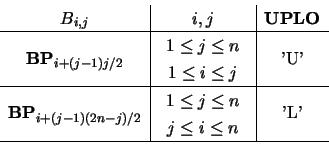




Next: Example (from Program LA_HPGVX_EXAMPLE)
Up: Generalized Symmetric Eigenvalue Problems
Previous: Purpose
Contents
Index
- AP
- (input/output) REAL or COMPLEX
array, shape
 with
with  (AP)
(AP)  , where
, where  is the order of
is the order of  and
and  .
.
On entry, the upper or lower triangle of matrix
 in packed storage. The elements are stored
columnwise as follows:
in packed storage. The elements are stored
columnwise as follows:
On exit, the contents of AP are destroyed.
- BP
- (input/output) REAL or COMPLEX
array, shape
 with
with  (BP)
(BP)  (AP).
(AP).
On entry, the upper or lower triangle of matrix
 in packed storage. The elements are stored columnwise as follows:
in packed storage. The elements are stored columnwise as follows:
On exit, the triangular factor  or
or  of the Cholesky
factorization
of the Cholesky
factorization  or
or  , in the same
storage format as
, in the same
storage format as  .
.
- W
- (output) REAL array, shape
 with
with
 .
.
The eigenvalues in ascending order.
- ITYPE
- Optional (input) INTEGER.
Specifies the problem type to be solved:
![\begin{optionarg}
\item[{= 1:}] $A z = \lambda B z$ \item[{= 2:}] $A B z = \lambda z$ \item[{= 3:}] $B A z = \lambda z$ \end{optionarg}](img789.gif)
Default value: 1.
- UPLO
- Optional (input) CHARACTER(LEN=1).
![\begin{optionarg}
\item[{$ =$\ 'U':}] Upper triangles of $A$\ and $B$\ are stor...
...item[{$ =$\ 'L':}] Lower triangles of $A$\ and $B$\ are stored.
\end{optionarg}](img791.gif)
Default value: 'U'.
- Z
- Optional (output) REAL or COMPLEX rectangular
array, shape
 with
with
 and
and  (Z,2) = M.
(Z,2) = M.
The first M columns of Z contain the orthonormal
eigenvectors corresponding to the selected
eigenvalues, with the  column of Z holding the
eigenvector associated with the eigenvalue in W
column of Z holding the
eigenvector associated with the eigenvalue in W . The eigenvectors are
normalized as follows:
. The eigenvectors are
normalized as follows:
![\begin{optionarg}
\item[{if ${\bf ITYPE} = 1$\ or $2$:}] $Z^H\,B\,Z = I$,
\item[{if ${\bf ITYPE} = 3$:}] $Z^H\,B^{-1}\,Z = I$.
\end{optionarg}](img786.gif)
If an eigenvector fails to converge, then that column of Z
contains the latest approximation to the eigenvector and the
index of the eigenvector is returned in IFAIL.
- VL,VU
- Optional (input) REAL.
The lower and upper bounds of the interval to be searched
for eigenvalues. VL  VU.
VU.
Default values:
VL  -HUGE(wp) and VU
-HUGE(wp) and VU  HUGE(wp),
where wp ::= KIND(1.0)
HUGE(wp),
where wp ::= KIND(1.0)  KIND(1.0D0).
KIND(1.0D0).
Note: Neither VL nor VU may be present if IL and/or IU
is present.
- IL,IU
- Optional (input) INTEGER.
The indices of the smallest and largest eigenvalues to be
returned. The  through
through  eigenvalues
will be found.
eigenvalues
will be found.
 .
.
Default values: IL  and IU
and IU 
 (A,1).
(A,1).
Note: Neither IL nor IU may be present if VL and/or VU
is present.
Note: All eigenvalues are calculated if none of the arguments VL, VU,
IL and IU are present.
- M
- Optional (output) INTEGER.
The total number of eigenvalues found.
 .
.
Note: If  and
and  are present then
are present then
 .
.
- IFAIL
- Optional (output) INTEGER array,
shape
 with
with  (IFAIL)
(IFAIL) 
 (A,1).
(A,1).
If INFO  , the first M elements of IFAIL are zero.
, the first M elements of IFAIL are zero.
If INFO  , then IFAIL contains the indices of the
eigenvectors that failed to converge.
, then IFAIL contains the indices of the
eigenvectors that failed to converge.
Note: If Z is present then IFAIL should also be present.
- ABSTOL
- Optional (input) REAL.
The absolute error tolerance for the eigenvalues.
An approximate eigenvalue is accepted as converged
when it is determined to lie in an interval ![$[a,b]$](img624.gif) of width less than or equal to
of width less than or equal to
where wp is the working precision. If ABSTOL  , then
, then
 will be used in its place,
where
will be used in its place,
where  is the
is the  norm of the tridiagonal matrix
obtained by reducing the generalized eigenvalue problem to tridiagonal form.
Eigenvalues will be computed most accurately when ABSTOL is
set to twice the underflow threshold
norm of the tridiagonal matrix
obtained by reducing the generalized eigenvalue problem to tridiagonal form.
Eigenvalues will be computed most accurately when ABSTOL is
set to twice the underflow threshold
 , not zero.
, not zero.
Default value:  .
.
Note: If this routine returns with
 , then some
eigenvectors did not converge. Try setting ABSTOL to
, then some
eigenvectors did not converge. Try setting ABSTOL to
 .
.
- INFO
- Optional (output) INTEGER.
![\begin{infoarg}
\item[{$= 0$:}] successful exit.
\item[{$< 0$:}] if {\bf INFO}...
...d and
no eigenvalues or eigenvectors were computed.
\end{infoarg}\end{infoarg}](img855.gif)
If INFO is not present and an error occurs, then the
program is terminated with an error message.
References: [1] and [17,9,20,21].





Next: Example (from Program LA_HPGVX_EXAMPLE)
Up: Generalized Symmetric Eigenvalue Problems
Previous: Purpose
Contents
Index
Susan Blackford
2001-08-19


![\begin{optionarg}
\item[{= 1:}] $A z = \lambda B z$ \item[{= 2:}] $A B z = \lambda z$ \item[{= 3:}] $B A z = \lambda z$ \end{optionarg}](img789.gif)
![\begin{optionarg}
\item[{$ =$\ 'U':}] Upper triangles of $A$\ and $B$\ are stor...
...item[{$ =$\ 'L':}] Lower triangles of $A$\ and $B$\ are stored.
\end{optionarg}](img791.gif)
![\begin{optionarg}
\item[{if ${\bf ITYPE} = 1$\ or $2$:}] $Z^H\,B\,Z = I$,
\item[{if ${\bf ITYPE} = 3$:}] $Z^H\,B^{-1}\,Z = I$.
\end{optionarg}](img786.gif)
![\begin{infoarg}
\item[{$= 0$:}] successful exit.
\item[{$< 0$:}] if {\bf INFO}...
...d and
no eigenvalues or eigenvectors were computed.
\end{infoarg}\end{infoarg}](img855.gif)